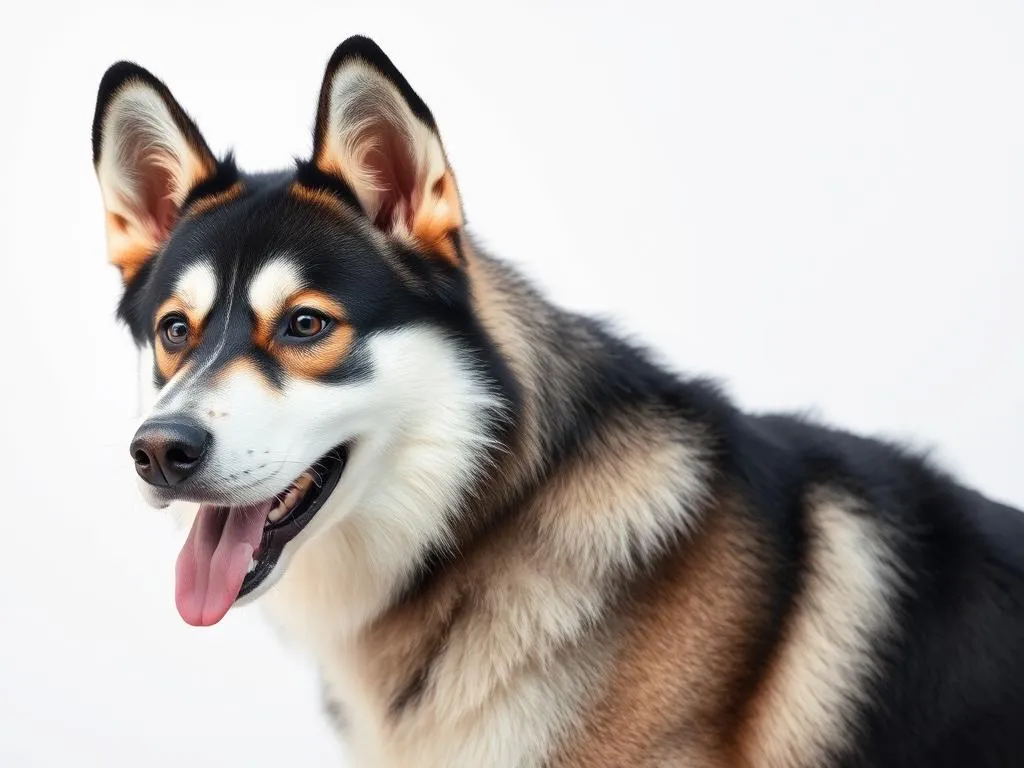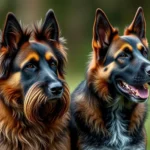
Introduction
Mixed dog breeds have surged in popularity over the past few decades, captivating the hearts of dog lovers worldwide. One intriguing hybrid that stands out is the Alaskan Husky German Shepherd mix, a combination of two remarkable breeds known for their intelligence, loyalty, and striking appearance. Understanding mixed breeds is vital for prospective pet owners, as each mix brings together unique characteristics and traits from its parent breeds.
In this article, we will delve into the fascinating world of the Alaskan Husky German Shepherd mix, exploring its physical and behavioral traits, care requirements, and much more. This comprehensive guide aims to equip potential owners with the knowledge they need to decide if this energetic and affectionate hybrid is the right fit for their lifestyle.
Understanding the Parent Breeds
Alaskan Husky
The Alaskan Husky is a breed primarily bred for their performance in sled dog racing. Originating in Alaska, these dogs were developed by Indigenous peoples for their work ethic, endurance, and ability to thrive in cold climates. Unlike the more standardized Siberian Husky, the Alaskan Husky is a mixed breed itself, incorporating traits from various breeds, resulting in a versatile and hardworking companion.
Physically, Alaskan Huskies vary widely in size, typically weighing between 35 to 65 pounds. Their coats are dense and come in a range of colors, including black, gray, and red, often featuring striking patterns. As for temperament, Alaskan Huskies are known for their friendly and playful demeanor. They are social dogs, thriving on companionship but can be independent and stubborn at times. Common health issues include hip dysplasia, eye problems, and certain genetic conditions.
German Shepherd
The German Shepherd is one of the most recognized dog breeds globally, renowned for its intelligence and versatility. Developed in Germany in the late 19th century for herding sheep, the breed has since excelled in various roles, including police work, search and rescue, and as service dogs. Their robust build and striking appearance make them a favorite among dog enthusiasts.
German Shepherds typically weigh between 50 to 90 pounds, with a well-defined muscular structure. Their coat is medium-length, usually black and tan, sable, or all black. In terms of temperament, German Shepherds are known for their loyalty, courage, and protectiveness. They are highly trainable and require mental stimulation to prevent boredom. Common health issues include hip and elbow dysplasia, degenerative myelopathy, and certain heart conditions.
Characteristics of the Alaskan Husky German Shepherd Mix
Physical Traits
The Alaskan Husky German Shepherd mix can exhibit a diverse range of physical traits, influenced by both parent breeds. Typically, they weigh between 40 to 80 pounds, making them a medium to large-sized dog. Their coat can vary significantly, often combining the dense, double coat of the Alaskan Husky with the medium-length coat of the German Shepherd.
Color variations can include black, gray, red, or a mix of these with white or tan markings. Unique features may include erect ears from the German Shepherd side and the striking facial markings often seen in Huskies.
Temperament and Behavior
The temperament of an Alaskan Husky German Shepherd mix is generally friendly, intelligent, and loyal. They are social dogs that thrive on companionship and typically get along well with children and other pets. However, they can also exhibit independent traits inherited from both parent breeds, leading to occasional stubbornness.
This mix is highly intelligent, making them relatively easy to train, although consistent and positive reinforcement is essential. They are energetic dogs requiring regular exercise and mental stimulation to keep them happy and content.
Lifespan and Health Considerations
The average lifespan of an Alaskan Husky German Shepherd mix ranges from 10 to 14 years. While mixed breeds often enjoy hybrid vigor, it’s essential to be aware of potential health concerns inherited from their parent breeds. Common issues may include hip and elbow dysplasia, eye problems, and certain skin conditions.
Regular veterinary care is crucial to monitor their health and address any concerns early. Ensuring a healthy diet and active lifestyle also contributes to their overall well-being.
Care Requirements
Nutrition
Providing proper nutrition is vital for the health of your Alaskan Husky German Shepherd mix. A balanced diet formulated for active, medium to large breeds is recommended. High-quality dog food that lists meat as the first ingredient helps meet their energy requirements.
Feeding schedules should be consistent, typically two meals per day, with portion control to prevent obesity. It’s advisable to consult a veterinarian for personalized dietary recommendations based on age, weight, and activity level.
Exercise and Activity Needs
As an energetic mix, the Alaskan Husky German Shepherd mix requires ample daily exercise—ideally, at least 1 to 2 hours. Activities can include long walks, runs, or playing fetch, which helps burn off excess energy.
Engaging in mentally stimulating games, such as puzzle toys or obedience training, is equally important. Socializing with other dogs and people is crucial for their development and helps curb potential behavioral issues.
Grooming and Maintenance
Grooming needs for the Alaskan Husky German Shepherd mix vary depending on the coat type inherited. Generally, they should be brushed at least once a week to manage shedding and keep their coats healthy. During shedding seasons, more frequent brushing may be necessary.
Bathing should be done as needed, typically every few months, to maintain cleanliness without stripping natural oils. Dental care, including regular brushing, and nail trimming should also be part of their grooming routine.
Training the Alaskan Husky German Shepherd Mix
Basic Training Techniques
Early training and socialization are crucial for an Alaskan Husky German Shepherd mix to develop into a well-rounded adult dog. Positive reinforcement techniques, such as treats and praise, work best with this intelligent mix. Basic commands like sit, stay, and come should be taught early on.
Socialization with a variety of people, environments, and other dogs is vital to prevent shyness or aggression. Puppy training classes can be beneficial for both training and socialization.
Behavioral Challenges
While generally well-behaved, the Alaskan Husky German Shepherd mix may face some behavioral challenges, such as stubbornness, barking, or digging. Addressing these issues early is key. Consistent training, along with redirecting unwanted behaviors positively, can be effective.
Enlisting the help of a professional trainer or attending obedience classes can also provide additional support. Understanding their needs and providing ample stimulation can help minimize behavioral problems.
Finding an Alaskan Husky German Shepherd Mix
Adoption vs. Buying
When considering an Alaskan Husky German Shepherd mix, prospective owners often face the choice between adoption and purchasing from a breeder. Adoption from shelters can provide a loving home to a dog in need while also being cost-effective. However, it’s essential to ask about the dog’s background, including any health or behavioral issues.
On the other hand, purchasing from a responsible breeder allows prospective owners to learn about the puppy’s lineage and health screenings. Regardless of the route taken, responsible ownership should remain a priority, ensuring the dog is well-cared for throughout its life.
Questions to Ask Breeders or Shelters
When evaluating breeders or shelters, asking the right questions can help ensure a healthy and well-adjusted puppy. Important inquiries include:
- Health screenings and genetic testing done on the parents
- Temperament of the parent breeds
- Socialization and early training experiences of the puppies
Asking these questions can help prospective owners make informed decisions.
Conclusion
In summary, the Alaskan Husky German Shepherd mix is a versatile and energetic hybrid that combines the best traits of its parent breeds. From their stunning physical appearance to their affectionate and intelligent nature, this mix can make a wonderful companion for an active family.
However, owning this mix comes with responsibilities, including training, exercise, and regular veterinary care. Prospective owners should carefully consider their lifestyle and ability to meet the needs of this engaging breed. With the right environment and commitment, the Alaskan Husky German Shepherd mix can bring joy, companionship, and adventure to any home.
FAQs
What is the average weight of this mix?
The Alaskan Husky German Shepherd mix typically weighs between 40 to 80 pounds, varying based on genetics.
Are they good with children?
Yes, this mix is generally good with children, especially when socialized properly from a young age.
How much exercise do they need daily?
An Alaskan Husky German Shepherd mix requires at least 1 to 2 hours of exercise each day to stay happy and healthy.
What are the potential health issues?
Common health issues include hip and elbow dysplasia, eye problems, and skin conditions, which can be inherited from the parent breeds. Regular veterinary check-ups are essential for early detection and management.
This comprehensive guide aims to provide valuable insights for those considering the Alaskan Husky German Shepherd mix. By understanding their needs and characteristics, prospective owners can ensure a fulfilling and happy life for their new furry companion.









